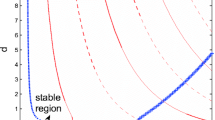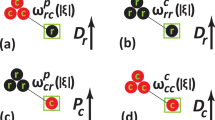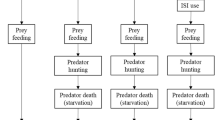Abstract
We present the results of simulations in an individual-based model describing spatial movement and predator-prey interaction within a closed rectangular habitat. Movement of each individual animal is determined by local conditions only, so any collective behavior emerges owing to self-organization. It is shown that the pursuit of prey by predators entails predator interference, manifesting itself at the population level as the dependency of the trophic function (individual ration) on predator abundance. The stabilizing effect of predator interference on the dynamics of a predator-prey system is discussed. Inclusion of prey evasion induces apparent cooperation of predators and further alters the functional response, giving rise to a strong Allee effect, with extinction of the predator population upon dropping below critical numbers. Thus, we propose a simple mechanistic interpretation of important but still poorly understood behavioral phenomena that underlie the functioning of natural trophic systems.
Similar content being viewed by others
References
A. J. Lotka, Elements of Physical Biology (Williams and Wilkins, Baltimore, 1925).
V. Volterra, Nature 188, 558 (1926).
G. F. Gause, The Struggle for Existence (Williams and Wilkins, Baltimore, 1934).
V. A. Kostitzin, Biologie Mathematique (Librairie Armand Colin, Paris, 1937).
Yu. M. Svirezhev and D. O. Logofet, Stability of Biological Communities (Nauka, Moscow, 1978) [in Russian].
R. Arditi and L. R. Ginzburg, How Species Interact: Altering the Standard View on Trophic Ecology (Oxford Univ. Press, Oxford, 2012).
P. A. Abrams and L. R. Ginzburg, Trends Ecol. Evol. 15, 337 (2000).
R. Arditi, J.-M. Callois, Yu. Tyutyunov, and C. Jost, Compt. Rend. Biol. 327, 1037 (2004).
Yu. M. Svirezhev, Ecol. Model. 216, 89 (2008).
C. S. Holling, Can. Entomol. 91(5), 293 (1959).
M. L. Rosenzweig and R. H. MacArthur, Am. Naturalist 97, 217 (1963).
M. L. Rosenzweig, Science 171, 385 (1971).
R. F. Luck, Trends Ecol. Evol. 5, 196 (1990).
A. A. Berryman, in Theoretical Approaches to Biological Control, Ed. by B. A. Hawkins and H. V. Cornell (Cambridge Univ. Press, Cambridge, 1999), pp. 3–21.
R. Arditi and A. A. Berryman, Trends Ecol. Evol. 6, 32 (1991).
R. Arditi and L. R. Ginzburg, J. Theor. Biol. 139, 311 (1989).
C. X. J. Jensen and L. R. Ginzburg, Ecol. Model. 188, 3 (2005).
N. Sapoukhina, Yu. Tyutyunov, and R. Arditi, Am. Naturalist 162, 61 (2003).
H. R. Akçakaya, R. Arditi, and L. R. Ginzburg,, Ecology 76, 995 (1995).
M. Begon, J. L. Harper, and C. R. Townsend, Ecology: Individuals, Populations and Communities (Sinauer Associates, 1986).
D. L. DeAngelis, R. A. Goldstein, and R. V. O’Neill, Ecology 56, 881 (1975).
S. V. Berdnikov, V. V. Selyutin, V. V. Vasilchenko, and V. V. Caddy, Fisheries Res. 42, 261 (1999).
C. Cosner, D. L. DeAngelis, J. S. Ault, and D. B. Olson, Theor. Popul. Biol. 56, 65 (1999).
T. Park, Physiol. Zool. 27, 177 (1954).
V. S. Ivlev, Uspekhi Sovr. Biol. 24, 417 (1947).
V. S. Ivlev, Experimental Ecology of Fish Nutrition (Pishchepromizdat, Moscow, 1955) [in Russian].
M. P. Hassell and G. C. Varley, Nature 223, 1133 (1969).
J. R. Beddington, J. Anim. Ecology 44, 331 (1975).
Yu. Tyutyunov, L. Titova, and R. Arditi, Ecol. Complexity 5(1), 48 (2008).
Yu. Tyutyunov, L. Titova, F. A. Surkov, and E. N. Bakaeva, Zh. Obshch. BIol. 71, 52 (2010).
D. S. Contois, J. Gen. Microbiol. 21, 40 (1959).
L. R. Ginzburg, Yu. I. Gol’dman, and A. I. Railkin, Zh. Obshch. BIol. 32, 724 (1971).
C. Jost, G. Devulder, J. A., Vucetich, et al., J. Anim. Ecol. 74, 809 (2005).
J. A. Vucetich, R. O. Peterson, and C. L. Schaefer, Ecology 83, 3003 (2002).
J. P. DeLong and D. A. Vasseur, BMC Ecology 11, 1 (2011).
J.-Ch. Poggiale, J. Michalski, and R. Arditi, Bull. Math. Biol. 60, 1149 (1998).
R. Arditi, Yu. Tyutyunov, A. Morgulis, et al., Theor. Popul. Biol. 59, 207 (2001).
T. Tully, P. Cassey, and R. Ferriere, OIKOS 111, 479 (2005).
A. D. Bazykin, F. S. Berezovskaya, G. A. Denisov, and Yu. A. Kuznetzov, Ecol. Model. 14, 39 (1984).
W. C. Allee, Animal Aggregations: A Study in General Sociology (Chicago Univ. Press, Chicago, 1931).
P. A. Stephens and W. J. Sutherland, Trends Ecol. Evol. 14, 401 (1999).
P. H. Leslie, Biometrika 35, 213 (1948).
P. H. Leslie and J. C. Gower, Biometrika 47, 219 (1960).
C. Jost, Comparing predator-prey models qualitatively and quantitatively with ecological time-series data: PhD Thesis (Institute National Agronomique, Paris-Grignon, 1998).
J. H. Steele and E. W. Henderson, Am. Naturalist 117, 676 (1981).
A. D. Bazykin, Mathematical Biophysics of Interacting Populations (Nauka, Moscow, 1985) [in Russian].
S. V. Petrovskii and H. Malchow, Theor. Popul. Biol. 59, 157 (2001).
A. B. Medvinsky, S. V. Petrovskii, D. A. Tikhonov, et al., J. Biosci. 26, 77 (2001).
L. R. Ginzburg and M. Colyvan, Ecological Orbits: How Planets Move and Populations Grow (Oxford Univ. Press, Oxford, 2004).
L. R. Ginzburg and C. X. J. Jensen, Trends Ecol. Evol. 19, 121 (2004).
Author information
Authors and Affiliations
Corresponding author
Additional information
Original Russian Text © Yu.V. Tyutyunov, L.I. Titova, S.V. Berdnikov, 2013, published in Biofizika, 2013, Vol. 58, No. 2, pp. 349–356.
The text and presentation have been additionally amended for the English version. A.G.
Rights and permissions
About this article
Cite this article
Tyutyunov, Y.V., Titova, L.I. & Berdnikov, S.V. A mechanistic model for interference and Allee effect in the predator population. BIOPHYSICS 58, 258–264 (2013). https://doi.org/10.1134/S000635091302022X
Received:
Accepted:
Published:
Issue Date:
DOI: https://doi.org/10.1134/S000635091302022X




